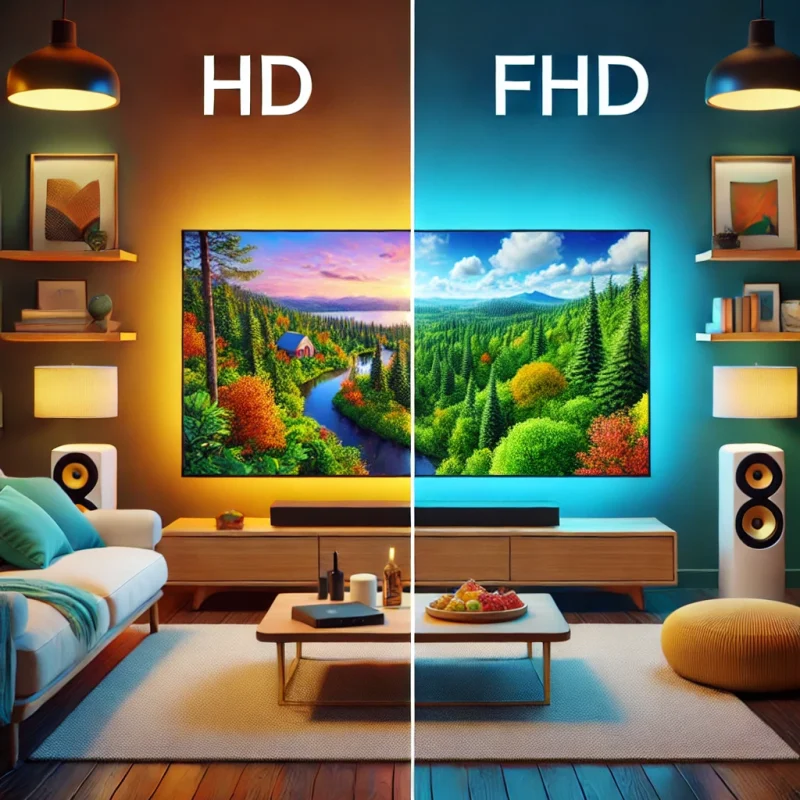Blog
HD and FHD quality: A complete guide to improving your viewing experience
What Does HD and FHD Mean for You?
The terms HD and FHD often come up when discussing screen resolutions, but how much do you actually know about them? For many, these terms may seem like technical jargon, but they represent a crucial part of your visual experience, whether you’re watching movies, playing games, or streaming your favorite series with our IPTV.
Understanding the differences between HD (High Definition) and FHD (Full High Definition) can make a significant difference when choosing the right screen for your needs. Whether you’re using a large TV, a gaming monitor, or a smartphone, knowing the strengths and limitations of each format allows you to get the best possible experience tailored to your equipment.
What is HD? The Basics of High Definition
HD, or High Definition, has been a cornerstone of the entertainment world for many years. With a resolution of 1280 x 720 pixels, HD was once considered the pinnacle of visual technology. It marked a significant leap from Standard Definition (SD), which typically maxed out at 480p, delivering sharper and clearer images that revolutionized home entertainment.
HD remains a popular choice today, especially for smaller screens like budget-friendly TVs, laptops, or tablets. Its ability to deliver a clear picture without requiring significant bandwidth makes it a practical option for those in areas with slower internet connections or for devices where higher resolution wouldn’t make a noticeable difference.
Advantages of HD Resolution
HD is cost-effective and a budget-friendly choice for those who want to keep costs low while still enjoying good picture quality. It works particularly well on smaller screens like tablets or smartphones, where the resolution is often sufficient to provide a sharp and pleasant experience. Because it requires less bandwidth, it’s also easy to stream HD content, making it accessible even in areas with slower internet connections.
When HD Falls Short
While HD was groundbreaking in its time, it has its limitations. On larger screens, the lower pixel density becomes more apparent, resulting in less sharp images compared to more advanced formats. HD also cannot deliver the immersive experience needed for gaming or streaming movies on modern high-resolution TVs.
What is FHD? The Full High Definition Explained
FHD, or Full High Definition, takes visual clarity to the next level with a resolution of 1920 x 1080 pixels. This format is widely used on modern TVs, computer monitors, and streaming services. FHD delivers sharper and more detailed images, making it ideal for larger screens and more advanced uses such as gaming or watching high-quality movies.
FHD offers greater detail and sharpness, making it especially suitable for larger screens where every pixel counts. It also provides a more immersive viewing experience, perfect for movie enthusiasts and gamers.
HD vs. FHD: Which One is Right for You?
The choice between HD and FHD depends on your specific needs. If you have a smaller screen or an older TV, HD might be sufficient. However, if you want to enjoy movies, games, or sports in the best possible quality, FHD is almost always the better choice. Larger screens benefit greatly from the additional detail that FHD provides, making the difference between the two formats even more noticeable.
How Does Resolution Impact Your Streaming Experience?
When it comes to streaming, both HD and FHD play a crucial role depending on your internet connection. HD requires less bandwidth, making it accessible for those with slower internet speeds. Meanwhile, FHD delivers a superior visual experience but demands a faster internet connection to avoid buffering or quality degradation.
Conclusion
HD and FHD represent two different levels of picture quality, and choosing between them depends on your needs and preferences. For a simple and budget-friendly solution, HD may suffice, while FHD offers a more detailed and immersive experience. Whatever you choose, it’s essential to consider your screen size, viewing habits, and internet connection to get the most out of your picture quality. Read our FAQs here!

